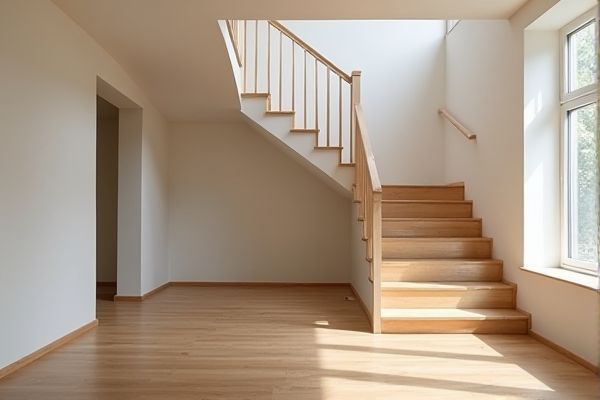
Box stairs offer a enclosed, compact design that maximizes safety and storage options, while open stairs provide an airy, modern aesthetic that visually expands your space. Explore the rest of the article to discover which stair style best suits Your home's functionality and style.
Table of Comparison
| Feature | Box Stairs | Open Stairs |
|---|---|---|
| Design | Enclosed with risers; solid appearance | Open risers; visually lighter |
| Safety | Higher; reduces falls and objects dropping | Lower; gaps increase risk for children/pets |
| Light & Space | Less light flow; can feel bulkier | Allows more light; enhances spaciousness |
| Cost | Generally more affordable and simpler | Tends to be costlier due to design complexity |
| Maintenance | Easier to clean; fewer nooks | Requires more cleaning due to open gaps |
| Applications | Traditional homes, commercial buildings | Modern homes, minimalistic designs |
Introduction to Box Stairs and Open Stairs
Box stairs feature enclosed stringers and solid risers, creating a traditional and sturdy appearance that enhances privacy and safety. Open stairs have open risers and exposed stringers, offering a modern, airy design that allows light to pass through and visually expands your space. Choosing between box stairs and open stairs depends on your style preferences, spatial constraints, and functional needs for your home.
Design Overview: Box Stairs vs Open Stairs
Box stairs feature enclosed risers creating a solid, geometric appearance ideal for contemporary and traditional interiors, offering increased privacy and structural stability. Open stairs, characterized by missing risers and often supported by stringers or cantilevers, provide a light, airy aesthetic that enhances spatial flow and visual openness in modern designs. Both styles significantly influence architectural ambiance and functional use of space, with box stairs emphasizing enclosure and open stairs promoting openness.
Aesthetic Appeal and Style Differences
Box stairs offer a clean, uniform look with enclosed risers that create a traditional or contemporary appeal, often complementing minimalist and formal interior designs. Open stairs feature visible treads without risers, fostering a spacious, airy atmosphere that enhances modern and industrial aesthetics. The choice between box stairs and open stairs significantly impacts the overall visual flow and perceived openness of the space.
Structural Integrity and Safety Comparison
Box stairs feature enclosed stringers that provide enhanced structural integrity, making them inherently more stable and capable of supporting heavier loads compared to open stairs. Open stairs, with exposed risers and minimal support, require careful engineering to meet safety standards but offer less resistance to lateral forces. Safety evaluations indicate box stairs reduce the risk of falls due to their solid construction and closed design, while open stairs may pose additional hazards if not properly maintained or equipped with adequate handrails.
Space Utilization: Which Maximizes Room?
Box stairs feature enclosed risers and solid sides, creating a more traditional look while potentially limiting under-stair storage options. Open stairs, with gaps between treads and open risers, maximize visual space and can make rooms feel larger and airier by allowing light and sight lines to pass through. Your choice depends on whether you prioritize maximizing usable under-stair space or enhancing the overall spatial openness in your home.
Material Options for Box and Open Stairs
Box stairs often utilize solid wood, metal, or MDF for their enclosed structure, providing durability and a wide range of finishes to match interior decor. Open stairs frequently feature materials like steel, glass, and wood, emphasizing a lightweight, airy design that maximizes light flow and space perception. Your choice between these stair types influences material selection based on aesthetic preferences, structural requirements, and the desired openness or enclosure in your living area.
Installation Complexity and Costs
Box stairs generally involve higher installation complexity and costs due to their enclosed structure requiring precise framing and finishing work. Open stairs offer simpler installation with fewer materials and faster assembly, reducing labor expenses. Choosing between the two depends on budget constraints and design preferences impacting overall project costs.
Maintenance Requirements and Longevity
Box stairs typically require less maintenance due to their enclosed structure, which protects the treads and risers from dust and damage, enhancing their longevity. Open stairs, while visually appealing and easier to clean from all sides, may need more frequent upkeep to prevent wear on exposed edges and open areas. Your choice will affect how much time and effort you spend preserving the stairs' appearance and durability over time.
Suitability for Different Interior Themes
Box stairs offer a clean, solid structure that suits traditional, minimalist, and modern interior themes by providing a sleek, enclosed look that complements streamlined designs. Open stairs, characterized by their airy, open risers, fit well with contemporary, industrial, and Scandinavian themes, enhancing spaciousness and allowing natural light to flow through. Both options can be customized with various materials and finishes to align with specific aesthetic preferences and functional requirements in diverse interior settings.
Choosing Between Box Stairs and Open Stairs: Key Considerations
Box stairs offer a more enclosed design that maximizes safety and provides structural stability, making them ideal for homes with children or limited space. Open stairs create a sense of spaciousness and modernity through their open risers and minimalist frames, enhancing natural light flow but requiring careful attention to safety standards. When choosing between box stairs and open stairs, factors such as safety needs, aesthetic preferences, available space, and overall architectural style should guide the decision.
 homyna.com
homyna.com